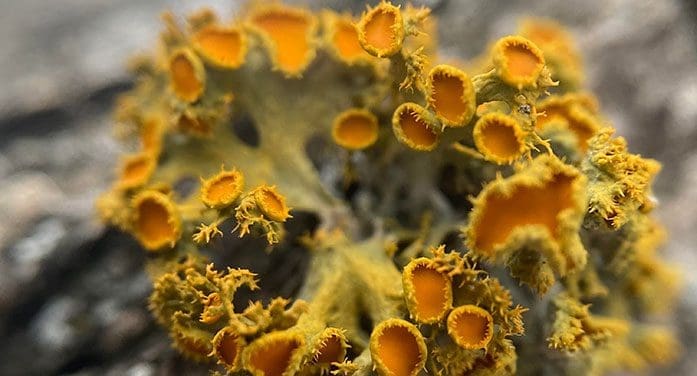Our understanding of the marriage of fungus and algae in the formation of lichen is being upended by a University of Alberta research team whose work is rewriting the biology that introduced symbiosis to the world.
“New discoveries happen with symbiosis all the time, but the exciting thing here is this is the symbiosis that got it all started,” says Toby Spribille, professor in the Faculty of Science and Canada Research Chair in Symbiosis.
“Lichens are literally what high school biology teachers use to teach symbiosis.”
Spribille explained symbiosis – often very tiny organisms working together through their metabolic abilities to get one thing done – was discovered in the 1860s by Swiss botanist Simon Schwendener, who determined that lichen was not one thing but rather a symbiotic partnership of a fungus and an alga.
 Toby Spribille |
 Lisa Willis |
Scientists thought then – and for the next 150-plus years – that the alga present photosynthesizes and produces sugars that the fungus takes up and uses to grow and fuel the lichen, in exchange for the structure and protection the fungus provides.
If this symbiotic relationship is as the textbooks suggest, then the genome of the fungus getting a sugar subsidy in exchange for protection, over the millions of years of evolutionary time, would lose the ability to make enzymes to break down more complex sugars, according to Spribille.
“That’s the way it works in fungi that are associated with trees; that’s the way it works in many of the types of interactions in gut organisms,” he says.
To test this hypothesis, Spribille and U of A glycomics specialist Lisa Willis looked at the genomes of 46 fungi that are involved in lichen symbiosis. Their results were published recently in the journal Nature Communications.
“Our look at these genomes is suggesting that it doesn’t work that way at all.”
Instead, the group found that the genomes of lichen fungi retained all kinds of different abilities to break down complex sugars, including some with an enzyme repertoire that closely resembles fermenters used in biotechnology.
“This calls into question the entire basis of lichen symbiosis,” he says.
Spribille explained what he thinks is happening is that the sugars being provided by the alga are not used to grow the lichen but instead are saved up to preserve cellular content when lichens dry out, which they do once a day.
He compares this discovery to going for dinner at the home of a lifelong vegetarian friend and finding a kitchen full of butcher knives and meat-grinding equipment.
“It doesn’t necessarily mean that they eat meat, but it raises a lot of questions,” says Spribille. “What we’ve done by walking into the lichen-fungal kitchen is see that they have the capacity to produce enzymes to do all sorts of things that we assumed they should not be able to do.”
Fungi fundamentals: the truth about mushrooms by Geoff Carpentier
Fungi have great names – turkey tail, pigskin poison, honey mushroom – and come in all shapes and sizes
These new processes are not fully understood, but Spribille hypothesizes these sugar alcohols are used to facilitate the phenomenon in which lichens dry out once every 24 hours down to just a two or three per cent water content.
He explained that while fungi need moisture to live, lichens have evolved the ability to escape from this need for constant moisture by developing a mechanism that allows them to dry out without dying.
The ability of lichens to dry out means they’re able to colonize the outside of tree bark and concrete and withstand melting 70C heat in deserts in southern Africa and even vacuum conditions and gamma radiation in space.
“This is the symbiotic system that introduced the concept of symbiosis to the life sciences,” notes Spribille. “This work really kind of shakes things up a little bit.”
| By Michael Brown
Michael is a reporter with the University of Alberta’s Folio online magazine. The University of Alberta is a Troy Media Editorial Content Provider Partner.
The opinions expressed by our columnists and contributors are theirs alone and do not inherently or expressly reflect the views of our publication.
© Troy Media
Troy Media is an editorial content provider to media outlets and its own hosted community news outlets across Canada.

